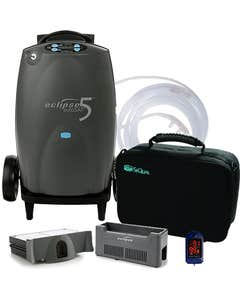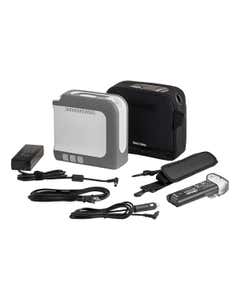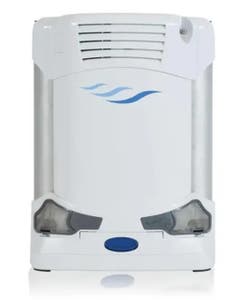Setting the oxygen level on your oxygen concentrator depends on the prescription given to you by your doctor. You should not choose your own settings unless your doctor has recommended a change. Making that adjustment is simple for most oxygen concentrators. Technicians or medical professionals are not needed. It’s easy to adjust yourself.

Types of Oxygen Concentrator Flow Settings
Continuous Flow Oxygen
Continuous flow oxygen provides a consistent stream of oxygen to the patient and a pre-determined rate of flow, regardless of the rate of the patient’s breathing. If your activity level is low to moderate and your breathing rate stays relatively consistent throughout the day, a continuous flow oxygen concentrator may be right for you.
Pulse Dose Oxygen
Pulse dose oxygen delivers oxygen based on the patient’s breathing. This type of oxygen flow is ideal for treating respiratory conditions that do not require a high LPM (liters of oxygen delivered per minute). The benefit of a pulse dose oxygen concentrator is that it works with your breathing needs as they change.
Prescription for Your Oxygen Concentrator Flow Rate
The option of a continuous flow or a pulse dose oxygen concentrator depends on the prescription from your doctor. Your doctor will recommend the type of oxygen therapy you need based on your respiratory condition. The doctor will also determine the flow settings, which will guide your choice of an oxygen concentrator. Oxygen concentrator providers will follow the doctor’s prescription as a way to help you review some options available to you.
Pulse Settings for Portable Oxygen Concentrators
| Oxygen Concentrators | Setting Range | Oxygen At Setting Of 1 | Max Setting | Oxygen At Max Setting |
| Caire FreeStyle Comfort Portable Oxygen Concentrator | Pulse Flow 1-5 | 210 mL/min | 5 | 150 mL/min |
| Caire SeQual Eclipse 5 All-in Portable Oxygen Concentrator | Continuous Flow Pulse Flow 1-9 | 16 mL/min | 9 | 192mL/min |
| DeVilbiss iGo Portable Oxygen Concentrator with Wheeled Case | Continuous Flow Pulse Flow 1-6 | 40 BPM | 3 Continuous Flow 6 Pulse Flow | Continuous Flow 3ml/min |
Pulse Settings for Home Oxygen Concentrators
Many patients, once they see “liters per minute” on their prescription, assume their only option is a continuous-flow oxygen concentrator or tank. In reality, both pulse and continuous units use LPM or liters per minute. LPM actually refers to the flow rate of oxygen you’re prescribed. Flow rates are measured in liters of oxygen flowing through the cannula and past the nasal passages. The vast majority of people are prescribed 2 liters of oxygen per minute (2LPM).
Pulse flow puffs or pulses oxygen into your nasal passageway, through a cannula, with each breath. This means that oxygen is delivered only during inhalation and the device stores the oxygen when you exhale. Should the breathing rate increase, the oxygen concentrator will automatically adjust the pulse size and delivery frequency to maintain the required flow rate.
Portable Oxygen Concentrator Up To 10 Liters
Sometimes an oxygen concentrator with a high flow is necessary to meet a patient’s oxygen requirements. A higher setting is often needed for more severe cases of low oxygen in the bloodstream. When someone with healthy lungs takes a breath, they are really only breathing in 21% oxygen in the air.
Portable concentrators can’t be high flow because they need to be small enough to carry around comfortably. High continuous flow oxygen concentrators are more powerful and need to be larger to hold all the inner workings needed to run on high settings.
Home Oxygen Concentrator 10 Liters
High flow home oxygen concentrators have settings that go as high as 10 LPM (liters per minute) of continuous flow. Some can go only up to 5 LPM. While the highest settings that POCs have are 3 LPM and 196 ml/min of pulse dose oxygen.
Many high flow 10 liter oxygen concentrators have a humidifier that can be used on the high oxygen flow setting. The humidifier is necessary on the higher oxygen settings because the higher flow of air can be much drier and more irritating to the airways. The humidity helps to cut down on irritation and issues like a bloody nose or sore throat. You may even need to use this on the lower settings during particularly dry times of the year.
Overview on Oxygen Concentrator Settings
Understanding how to set your oxygen concentrator settings lets adjust a new oxygen concentrator to the prescription provided by your doctor. If recommendations from your doctor change, you can easily adjust settings. In some instances, you may have to switch from a pulse flow to a continuous flow setting, which requires an oxygen concentrator that offers both options.
How to Set the Oxygen Level on A Concentrator
Locate the liter control knob or switch on your oxygen concentrator. The knob or switch will likely have numbers next to it, though the exact markings will depend on your model.
Turn the knob or switch until it points to your prescribed number. Your doctor will prescribe the appropriate amount of oxygen for you. If you aren’t sure about which setting to use, call your doctor for clarification.
Home Oxygen Concentrator Flow Settings
Setting up your home oxygen concentrator starts with understanding if you need pulse or continuous flow settings per your prescription. Try not to vary your settings, as the prescription determines the right amount of oxygen you need for your respiratory condition. Home units do not need to be changed often as they are stationary.
Portable Oxygen Concentrator Flow Settings
Portable oxygen concentrators may have variations in pulse flow settings based on battery charge. The higher the pulse flow setting the more battery power you will use up. Continuous flow settings also consume a lot of power. Be aware of how much battery power you will deplete if you are traveling with your portable oxygen concentrator. Let your doctor know if lower settings are possible to conserve energy while on the road.
Where Can I Get Oxygen Concentrators?
Once you have been prescribed an oxygen concentrator by your doctor you can begin shopping. You should decide whether you want a home oxygen concentrator or a portable oxygen concentrator. Some patients who need oxygen therapy long-term may purchase both. Make sure you find one that has the correct flow settings for your prescription.
You can also shop online from the convenience of your own home. The Oxygen Concentrator Supplies Shop carries both types of oxygen concentrators from major manufacturers. The knowledgeable staff can help you select a model that best fits your prescription.
This post was originally published on June 28, 2022, and updated on January 11, 2024.






